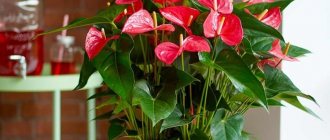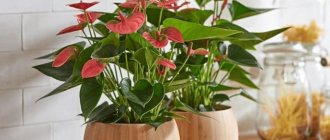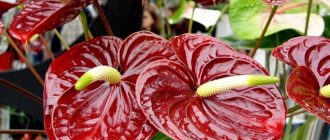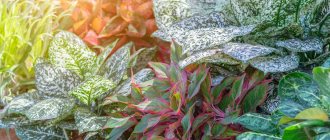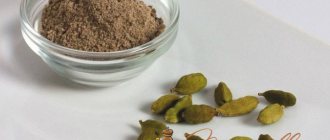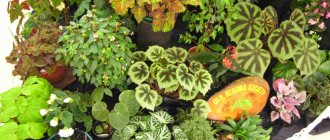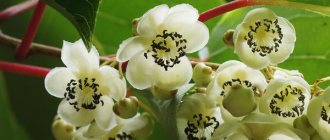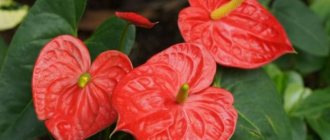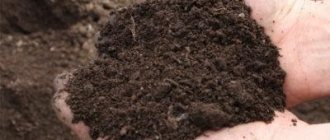It is no coincidence that the most popular type of anthurium with corkscrew-shaped inflorescences surrounded by large bright blankets has become a favorite of both amateurs and professional designers. A fashionable orange-red palette and impeccable appearance are characteristic of all compact varieties of Scherzer anthurium. Like and much more unpretentious than other anthuriums. If you choose the right conditions, the Scherzer anthurium will become a real star of any interior. And a great gift for any occasion. This neat plant with a special strict charm surprises with its appearance, character, and versatility.
Anthurium Scherzer is the most unpretentious and compact species. © decoracion__verde
Anthurium Scherzer description, photo
Scherzer's Anthurium (Anthurum scherzerianum) is an evergreen perennial that delights its owners with beautiful flowering. A representative of the Araceae family, the most numerous genus, uniting over 600 varietal species of evergreen liana-like and herbaceous crops. It is the Scherzer species that is most in demand among lovers of home crops. The name exotic comes from the Latin anthos - “flower” and oura - “tail”. The literal translation is “flower tail,” which fully corresponds to its appearance.
The culture comes from Central and South America. It has a short stem, rich green foliage on petioles 15-20 cm long. The foliage is collected in rosettes, and the curved inflorescence, similar to an orange cob, is wrapped in a heart-shaped red plate. At the end of flowering, round fruits of a fiery scarlet tone are formed. One representative can form up to eight flowers, delighting with their beauty for several months.
The culture has a popular name - “male happiness”. According to signs, this flower gives men health and longevity. The culture has several species and varietals, which also contain very miniature forms. Despite the fact that the culture positions itself as an undemanding house flower, it can hardly be called unpretentious. For the correct formation of all decorative features, the plant requires proper care and compliance with certain care requirements.
Reviews from happy owners
Anthurium Scherzer, caring for which is not particularly difficult for amateur gardeners, evokes a huge number of enthusiastic statements. Many speak of the flower as unpretentious, blooming throughout the year. Others are attracted by its elegance, and they speak with delight about the acquired exotic, although they add that it requires creating conditions close to natural ones. High humidity and sufficient lighting can create some difficulties.
There are many varieties of the Scherzer variety, and they are all attractive in their own way. There are variegated varieties, speckled, with a huge cob twisted in the form of a spiral with several curls. They are all very beautiful. Buy them and you will never regret it. They will delight your eyes for many years.
Popular varieties
Thanks to the work of breeders, today many miniature varieties of Anthurium with various shades of bracts have been developed. Among the most popular varieties presented in the windows of flower shops, these stand out.
Anthurium Scherzer
The most unpretentious variety among indoor varieties. The bush is rather low compared to its other brethren. The most popular Scherzer varieties are:
- “Lacetti” - this variety is grown not only as an indoor species, but also for cutting when decorating flower arrangements. It is distinguished by a peach-colored flower plate hugging a helical core-cob, fleshy foliage of a rich dark green tone with tapered ends.
- “Graffiti” - a distinctive feature of the variety is a wide white color plate with red specks and a fleshy structure.
- “Hawaii” - this exotic variety has gained popularity among soda growers due to the two- and three-color color of the flower plate.
- "Alexia Blue" - this species is distinguished by its flower cores of a soft blue tone, which makes it a favorite among gardeners.
- “Chocolate Love” - this variety has special decorative properties, which are manifested in the contrasting combination of dense shiny greenery with chocolate flower plates.
Indoor Anthurium Baker
Growing area: dense forests of Guatemala - Colombia. The foliage is dense and elongated. The inflorescence spadix is short, and the flower plate is creamy-green in color with a lilac border. At the end of the budding period, the plant produces rich scarlet fruits.
Anthurium Hooker
The exotic homeland is Trinidad, the Antilles, and monsoon forests. The foliage is large, peduncles reach a length of 80 cm. The flower ear is purple in color, the flower plate is soft green.
There are also these varieties: Anthurium Crystal and Clarinervium Clear-veined.
For your information! The most popular is Scherzer's anthurium mix, which consists of several varieties grown in one container.
Fiorino
The main thing is that I water only once a week, and in the morning I simply moisten the leaves and flowers by spraying them. For the soil, they advised to make a mixture of peat with soil for the orchid - my anthurium reacted favorably to this. I feed it in spring and summer 2 times a month, in winter - 1 time.
And so far so good. They gave me Sweet Dreams. And no one told me how to care for it. First I flooded it, then dried it out, put it on the windowsill on the south side..... Seeing that my flower was already in its death throes, I went to the Internet for advice.
And thank God this article helped me revive my flower.
Now it is a huge bush, large flowers. Thanks for the great information in the article.
I have been breeding flowers for 10 years, and this beauty is among my favorites. In indoor cultivation, varieties with multi-colored and even black bracts have been bred. A brightly colored spathe covers the inflorescence spadix, which can be club-shaped, cone-shaped, spiral-shaped or spherical in shape and of different colors. The flowers themselves are densely located on the cob and look like diamonds and squares. Flowers of different species smell differently, from a barely noticeable aroma to a very strong aroma, pleasant or foul.
Anthurium can bloom all year round with sufficient lighting and the flowers stay on the plant for a long time, up to a month and a half. This inflorescence has a large spathe of a delicate lemon shade and a white spadix with a green tip.
Two-color anthurium hybrids under the common name Obake are of Hawaiian origin and amaze the imagination with unusual combinations of shades on large bracts. The name Obake translated from Japanese means something changeable, unsteady. This word is also used to describe ghosts. The coloring of Rainbow Obake anthurium is more complex and includes not two shades, but much more.
Anthurium Andrianum Black Love (Anthurium Black Love)
Dark pink veins and a more delicate coating are visible on a white background. The base of the bract is colored in a beautiful green tone. Its characteristic feature is a light, almost white spot in the center of the blanket and a soft green surrounding. The veins are pink and the cob is white and yellow. The name of this anthurium variety, Watermelon Obake, very accurately describes the appearance of the inflorescence with a pink, juicy center and green edges.
Today in culture there are red, pink, white, purple, lilac and blue anthuriums of this type. Anthurium Fiorino with a tulip-shaped cover of a rich pink-violet hue belongs to the group of small anthuriums. The shape of the inflorescences is very laconic, and thanks to it the plant easily fits into any interior. The colors of the spathe and the spadix of the Fiorino anthurium are bright, and flowering lasts about 4 months. The blue anthurium Princess Alexia Blue will not amaze with the size of the inflorescence, but it will certainly not leave indifferent lovers of unusual colors.
Popular articles Caterpillars on roses - how to treat them
Both the cob and the spathe of this variety are painted in a beautiful ultramarine hue. But as it matures, green strokes appear at the base of the bedspread.
Anthurium lat. Anthurium is a member of the Araceae family of evergreen plants. The largest class of its family. According to various sources, there are about genera and species.
No less bright is the yellow anthurium of the Princess Alexia variety with a small bract and a short straight cob. The bright inflorescence is perfectly visible against the background of compact dark foliage. Anthurium variety Joli is a miniature representative of a large family of indoor plants. The size of the rosette does not exceed 15-18 cm, which allows you to find a place for a rather small anthurium with a pink bract and the same spadix on the tightest windowsill.
Why does your favorite anthurium turn yellow and dry out? What to do if indoor anthurium does not bloom for a long time? Experienced flower growers tell us how to care for anthurium... Home Flowers and plants Photos and descriptions of popular varieties of anthurium. Flowers and plants. Show comments 1.
Home care
Do not forget that the culture came to us from the tropical zone, therefore, home cultivation must fulfill all the requirements for the microclimate.
Location and lighting
In order to obtain the necessary lighting, the pots are placed on the window sills facing the northeast and northwest sides. The indoor flower prefers partial shade and diffused lighting. If there is insufficient light, it will be difficult to wait for the bush to bloom. And exposure to direct rays of the sun will cause the bush to dry out.
Air temperature and humidity
Temperature requirements vary depending on the season. During the spring and summer periods of active development, it is recommended to maintain the temperature within the range of 18-25. In the warm season, it will be quite common to feel exotic in an open area, but as far away from direct sunlight as possible. With the onset of cold autumn and throughout the winter, it is necessary to reduce the temperature to 15-17 degrees. By observing the temperature conditions, the plant will have the opportunity to properly lay flower stalks.
The flower has one feature - it requires a humidity level of 85-90%. This requirement can be met by placing the pot on a special stand with moistened expanded clay. Every day, the foliage must be wiped with a damp sponge or sprayed with a sprayer, without getting on the flower stalks. Moss or coconut fiber, which can be used to cover the surface of the soil in a container, will also help in the solution. In the future, when moistening the bush, it is necessary that the moisture-retaining material is also moistened.
Important! In winter, it is necessary to protect the plant from frosty drafts and sudden changes in temperature.
Watering and fertilizing
For watering, use soft filtered water. Before use, it is better to boil the water, let it cool and add a few drops of lemon juice. Watering is carried out regularly, but only if the substrate dries out approximately 5 cm deep. Excessive moisture or drying out of the soil has a detrimental effect on full growth and formation. High soil moisture will lead to rotting of the root system, and lack of moisture will lead to drying out.
Full care of anthurium involves the additional use of mineral and organic fertilizers. At the active growth stage, universal fertilizers are added to the soil at regular intervals of 10-14 days. It is important not to allow an excess of fertilizers. To do this, more experienced gardeners recommend making solutions of lower concentrations than the manufacturer indicates on the packaging. It is also necessary to ensure that the fertilizer does not contain lime. During the cold winter period, fertilization is not required.
Soil, pot, replanting
The crop can be grown in specialized soil, in treated pine bark, or using the hydroponics method. When using pine bark, an increase in the number of waterings and fertilizing will be required. The optimal substrate is considered to be a mixture of two parts of moss and peat, and one part of turf soil. You can add a little charcoal and ground bark. This mixture will provide the soil with good oxygen and moisture permeability.
Informative! The crop begins to bloom only after the entire volume of the pot is filled with roots. Therefore, it is not recommended to transplant into excessively large containers; each subsequent pot can be 1 cm larger than the previous one.
When it comes to soil, one very important rule must be observed - the substrate should not be compressed or compacted. The soil mixture should remain loose and fibrous and maintain excellent breathability. For the proper development of exotic plants, slightly acidic soil is preferred. Therefore, it is recommended to maintain the acidity level in the range of 5.0-6.0.
Young bushes are replanted every year. But replanting bushes older than 5 years is performed as needed, as a rule, no more than once every 3-4 years. The root system of the exotic plant is fragile and brittle; as a result, extreme care should be taken when moving the bush. For further development of the root system and the formation of new shoots during the transfer process, the plant goes slightly deeper into the new substrate.
Reproduction methods
The culture can reproduce in several ways:
- seed;
- dividing the bush;
- cuttings;
- lateral processes.
The seed propagation method in this case is a very difficult and unproductive process. As a rule, it is used by breeders to obtain new species. And a flower grown from seeds will bloom no earlier than 3-4 years later.
The most effective method of growing anthurium is dividing the bush. This method is performed by dividing the mother flower into cuttings. The most suitable time for cuttings is considered to be spring. The plant is removed from the container and young shoots along with the root system are carefully separated from the general bush. The separation area is treated with crushed coal. The resulting seedlings are transferred to separate containers filled with nutrient soil.
Most species are able to reproduce by cuttings. A part of the shoot with aerial roots is selected and cut off at an angle. The cut site is dipped in a means for rapid root growth. The selected shoot is planted in moistened vermiculite, buried 3-5 cm into the soil.
Cover the top with a jar or bottle to create a greenhouse effect. For good rooting, high air humidity, a temperature of 23-25 degrees Celsius, and long daylight hours with diffused lighting are required. When the cutting has formed roots about 5 cm long, it can be transplanted into a container with a nutrient mixture.
Reproduction by lateral shoots is also often called reproduction by “babies”. During the process of transplanting the main bush, the side shoots are separated with a sterile scalpel and transferred to a moistened mixture of sand and peat to form the root system. Once the seedlings have formed a root ball, they can be transferred to containers for continued growth.
Know! You can replace vermiculite with soft water. In it, shoots can grow roots with the same ease.
How does it reproduce
Anthurium - home care: transplantation
The flower can reproduce by seeds, but then the flowering time will come later. In addition, there is a risk of the inflorescences not retaining their unique color. Therefore, for propagation it is recommended to use the method of dividing the bush. It is better to carry out the procedure in the spring.
To do this, you need to take an adult plant, pull it out of the pot and divide the roots into parts. Planting of the separated parts of the bush is carried out in small pots with peat.
The plant can be propagated by stem, lateral or apical cuttings, which are placed in water for rooting.
Flower cuttings
Anthurium mix
Mix is a compact variety among its brothers. A distinctive feature is its miniature size. The height of the mix does not exceed 20cm. This hybrid is created from a couple of the most popular varieties. This variety was bred by breeders and is well adapted to indoor breeding conditions. And the variety of colors can decorate any room.
Mixes do not require special care. Often, mixes are mini-plants, which allows you to grow several specimens on the windowsill at once. The juxtaposition of several mixes with different colors is especially fascinating, because there is quite a large selection of them - from milky white to a bright scarlet flower. From all the variety, you just need to choose a copy to your liking.
Anthurium Andre mix is an evergreen representative of the exotic. The leaves are large, juicy, fleshy, dense green in color. The bract has a heart shape and can be snow-white, orange, scarlet, green, or pink in color. If you follow the rules of care and maintenance, flowering continues throughout the year. flowering continues throughout the year. The maximum height of the stems can reach 75-80 cm.
Anthurium Scherzer mix - has a fairly small size. The foliage is slightly elongated and shaped like a heart. The bract plate is generally slightly elongated oval in shape. The most common are pink, fiery yellow and scarlet-orange shades. The inflorescence of the hybrid has been preserved in its original form - a spiral shape. This hybrid has not gained much popularity, but caring for it is very simple and does not take much time.
Anthurium mix by Andre and Scherzer - bred using the most popular species, the names of which are displayed in the title. The color of the flower bedspread can vary from soft white to deep scarlet tone. It all depends on the varietal variety. Green, pink and orange tones may also be found. It can reach 80 cm in height, but often grows 50-60 cm in height. Breeders worked to ensure that the hybrid became as unpretentious as possible and adapted to home cultivation. Flower growers love this cut flower.
Appearance of the flower
Anthurium is very remarkable for its flowering. For its low growth, it has rather large buds of different colors. Most often, a Scherzer is found with a red veil and a bright orange cob. It is recommended to grow for beginners in floriculture; it is the most unpretentious in care compared to other species. In recent years, flower growers have developed more than 40 types of hybrids of different colors. You can find one for every taste and shade.
The Anthurium Scherzer flower looks unusual and at the same time very beautiful. It consists of a bright yellow, bright orange or red spiral-shaped cob approximately 10 cm long, a heart-shaped spathe about 15 cm long and 5-6 cm wide. The color of the spathe can be varied: from pure white to various variants of mixed buds.
When the flower fades, bright orange or red berries appear on it; on some plants their number reaches 90-100 pieces.
Anthurium Scherzer mix home care
In order for an exotic flower to delight with its unsurpassed beauty of flowering, it is extremely important to choose the right place for growth. This should be the western or eastern side. It is also necessary to control the level of humidity and air temperature, because this exotic beauty is accustomed to the warm climate of the tropics. But at the same time, water stagnation in the soil should not be allowed, because then the risk of rotting of the root system increases. Exposure to drafts on crops is strictly prohibited.
Remember! The root system of anthurium develops very well, regardless of the age of the plant. Therefore, the culture must be periodically transplanted into a container of larger diameter.
Transfer
Anthurium Scherzerianum is recommended to be replanted every spring. This applies to young specimens. Then the interval increases to 3-4 years. Pay attention to the development and filling of the pot with the root system.
Anthurium is replanted by dividing the root system
Instructions for planting a houseplant:
- The container is chosen narrow and tall. This will ensure that the indoor plant blooms as quickly as possible.
- A small amount of drainage or expanded clay is poured into the bottom.
- A layer of soil with a loose structure is created on top.
- The plant is placed by transshipping it.
- The remaining space in the pot is filled with fresh soil.
- The soil is slightly compacted. Watering is in progress.
Diseases, pests and control methods
All crop diseases are associated with specific growing conditions. It can be affected by all kinds of rot caused by excessive soil and air moisture. The disease can only be defeated at an early stage of its manifestation. To do this you need:
- remove affected areas of roots or shoots;
- transplant the bush into a new container with fresh substrate and treat with fungicides.
Anthracnose is a particularly dangerous disease. It can be transmitted from an affected bush to a healthy one, or settle on a plant after watering. Signs of this disease are drying of the leaves along the contour and their further death.
An exotic guest can be attacked by such harmful insects as spider mites, aphids, mealyworms, thrips, scale insects, and whiteflies. The presence of parasites is accompanied by certain symptoms. Most often, bushes are affected by spider mites. The consequences of the attack of the parasite are yellowing of the leaves and the appearance of specks on their surface. Initially the specks are yellow in color, but over time they turn black.
When aphids multiply, the greenery on the bushes wrinkles and becomes covered with yellow spots. Mealyworm leaves behind chewed holes in the foliage.
Scale insects are the most common and dangerous enemy. It can take months to fight this pest. It will take a lot of effort and patience to rid the flower of the persistent parasite. The scale insect and its larvae leave a yellow sticky coating on the surface. The insect draws all the vital juices from the bush. As a result of such proximity, the plant loses its vitality, the foliage turns yellow and becomes deformed, and the growth and development of the bush stops.
Any pest is eliminated by spraying the bush with insecticidal preparations prepared in strict compliance with the manufacturer’s instructions. It is also necessary to remove all visible individuals and their larvae from the surface of the bush. Cut off injured shoots, peduncles and leaves.
Remember! If the affected plant is not treated, it will die. In addition, infection of neighboring crops is possible.
Video gallery
Cover the soil around the anthurium with moist sphagnum. This will retain moisture in the soil without watering the plant too often.
The flower feels most comfortable on the east or west side. On eastern and southern windows, the plant should be shaded in the morning from the hot rays of the sun.
Important: matte anthurium leaves easily get burned. Do not place the plant in the sun.
On northern windows, anthurium does not have enough light to bloom abundantly, so you will have to use artificial lighting, especially in the period from late autumn to early spring.
You need to water the plant with warm, soft water, to which it is useful to add a little citric acid so that the calcium salts settle. The soil in the pot should not dry out. When watering, be guided by the soil moisture and remember, the flower does not tolerate stagnation of liquid in the pot. From March to November, combine watering with fertilizing with liquid fertilizers for flowering indoor plants in accordance with the instructions. If anthurium blooms in winter, it continues to be fed regardless of the calendar.
Replanting is needed once every 2 years, when the roots fill the entire volume of the pot. For large specimens, the diameter of the pot should be no more than 20 cm.
Interesting: if the pot is too small, the anthurium blooms more profusely. In a pot that is too spacious, water stagnates and the roots of the plant rot.
The soil for Scherzer's anthurium needs to be loose, with a large proportion of peat and perlite. Add turf soil, crushed tree bark, river sand, charcoal, sphagnum and granular fertilizer to it. From ready-made soils, a soil mixture for orchids, aroids and bromeliads is suitable.
Anthurium propagation occurs easily by dividing the bush during transplantation. Lateral layers take root in moist peat within a month. It is advisable to cover the planted specimens with polyethylene. Remove it every day to ventilate the plant.
Anthurium begins to hurt if the following mistakes are made when caring for it:
- the soil is waterlogged or overdried;
- no drainage;
- the plant is in an unheated room at a temperature below +15ºC;
- the pot is in a draft;
- the leaves are exposed to direct sunlight;
- the room is too dry.
Anthurium reacts to discomfort by changing the color of the leaves: they turn yellow, yellow-brown spots appear, and the edges of the leaf blade dry out. The buds on the plant appear later than usual, flowering ends earlier, but in most cases it does not bloom at all.
Anthurium is affected by spider mites, scale insects, mealybugs and fungal diseases. It is useful to wash the leaves of the plant with warm water and a solution of laundry soap. After this procedure, the use of insecticides and fungicides will be more effective.
Possible growing problems
In fact, the flower is very unpretentious and if you take care of the plant, there will be no problems in growing it. However, novice flower growers, trying to fulfill all the requirements as much as possible, make many mistakes, which later lead to the development of diseases. But if the cause of the disease is detected in a timely manner and eliminated, the plant will quickly come to life.
If the maintenance conditions are violated and the flower is kept at low temperatures or in bright light, the foliage may turn yellow. A little later, dead areas form on the surface of the leaves. If the bushes are grown in heavy soil, or the drainage in the container is incorrect, the root system may rot. Such a plant must be transplanted immediately. Despite the fact that the crop is moisture-loving, excessive watering can also cause root rot.
In some cases, bushes do not produce buds for a long time. This problem can arise when there is insufficient lighting, too large a growing container, non-compliance with temperature conditions, or a lack of nutritional components in the soil. If all possible causes are eliminated, the flower will quickly delight you with a new peduncle.
Using hard and cool water causes the leaves to turn black. It is extremely important that the water for irrigation is filtered and at room temperature. Insufficient humidity in the room leads to blackening of the edges of the foliage.
Anthurium Scherzer and Andre differences
At first glance, these two species are very similar to each other. However, Scherzer's foliage is more elongated, the color plate is more oval, less glossy and sometimes slightly inverted. Scherzer, unlike Andre, is small in size. It reaches a height of 30 cm, which makes it more attractive for home gardeners. Another important difference is that in the Scherzer variety the inflorescence is twisted into a spiral, while in Andre it is straight. Andre's hybrid varieties are able to maintain flowering throughout the year, which cannot be said about its twin.
Botanical characteristics of the species
A plant with a short stem part and numerous thin roots. The foliage of the crop is prostrate, with cylindrical petioles. Sheet plates are characterized by moderate thickness. The leaves range from linear to elliptical and lanceolate in shape, with a gradual, slightly pronounced point at the apex.
The base is obtuse to wedge-shaped. The upper surface of the leaves is semi-glossy, the lower part of the leaf is matte, dark green in color. The upper central vein is sharply convex. The number of secondary veins can vary between eight and eleven pieces. The leaves of this species are covered on both sides with fairly small black dots.
Inflorescences are vertical, equal to or slightly longer than the foliage. The blanket is of moderate thickness, from elliptical to oval in shape. The small flowers are collected in a spirally twisted and fairly long cob, surrounded by a bright blanket, the color of which varies depending on the variety. The flowers are bisexual , protogenic, with no self-pollination. Anthuriums bloom in winter and spring. Flowering is quite long, and at least three months pass from the beginning of the opening of the inflorescences to the stage of their complete withering. The formed fruits are represented by orange and red berries, inside of which there are relatively small seeds.
